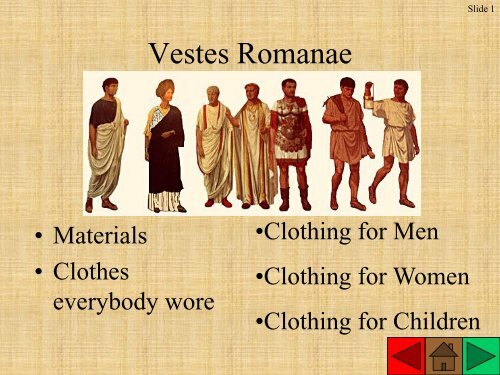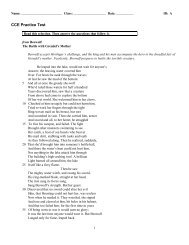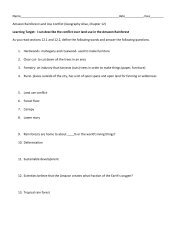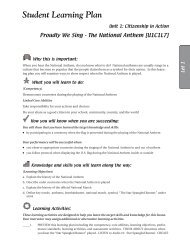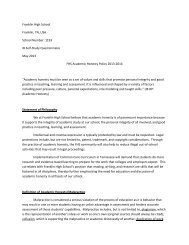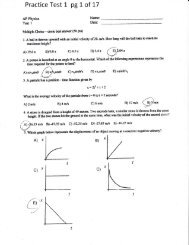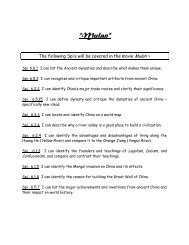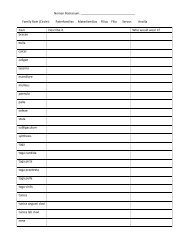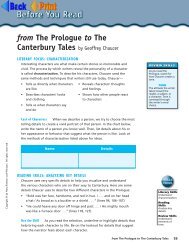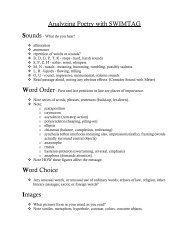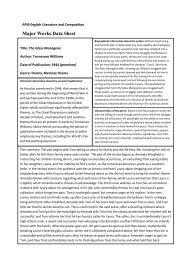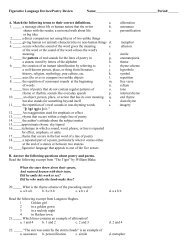You also want an ePaper? Increase the reach of your titles
YUMPU automatically turns print PDFs into web optimized ePapers that Google loves.
• Materials<br />
• Clothes<br />
everybody wore<br />
<strong>Vestes</strong> <strong>Romanae</strong><br />
•Clothing for Men<br />
•Clothing for Women<br />
Slide 1<br />
•Clothing for Children
• Romans did not<br />
have cotton or<br />
synthetic fabrics<br />
like rayon.<br />
• The average<br />
Roman’s clothes<br />
were made from<br />
sheep’s wool.<br />
Materials<br />
Slide 2
• If you were a<br />
wealthy Roman,<br />
you could afford<br />
silk from China.<br />
• Some cloaks and<br />
shoes were made<br />
from tanned<br />
leather.<br />
Materials<br />
Slide 3
Materials<br />
• The Romans<br />
liked to dress in<br />
bright colors, so<br />
they often dyed<br />
their cloth.<br />
• Most of their<br />
dyes came from<br />
vegetables.<br />
Slide 4
Materials<br />
• Purple or crimson dye,<br />
known later as the color<br />
of royalty, was the most<br />
expensive.<br />
• It came from a shellfish<br />
called a murex.<br />
Slide 5
Clothes Everybody Wore<br />
• Just like blue jeans<br />
Slide 6<br />
are today’s wardrobe<br />
standard, the Romans<br />
had clothes that<br />
everyone wore every<br />
day.<br />
• We’ll start with the<br />
tunica.
Clothes Everybody Wore<br />
Slide 7<br />
• The tunica looks like<br />
an oversized T-shirt.<br />
• Men, women, and<br />
children wore the<br />
tunica – sometimes<br />
alone, sometimes<br />
underneath other<br />
clothes.
Clothes Everybody Wore<br />
• Everyone wore shoes<br />
of some kind.<br />
• Leather calcei or<br />
soleae were common.<br />
• Soldiers wore boots<br />
called caligae.<br />
caligae<br />
Slide 8
Clothes NOBODY Wore<br />
Barbarians wearing bracae.<br />
• No Roman would<br />
be caught dead in<br />
bracae.<br />
• The long-sleeved<br />
tunica mandicata<br />
was for<br />
philosophers and<br />
sissies.<br />
Slide 9
• A male Roman<br />
citizen wore the<br />
Clothing for Men<br />
toga, a large draped<br />
garment, over his<br />
tunica.<br />
It was semicircular<br />
in shape, 18 feet<br />
wide and 7 feet<br />
deep.<br />
Slide 10
Clothing for Men<br />
• There were several<br />
different kinds of<br />
togae.<br />
• The basic white<br />
toga virilis was<br />
worn by all regular<br />
male citizens.<br />
Slide 11
Clothing for Men<br />
• The toga<br />
praetexta had a<br />
crimson border<br />
and was worn by<br />
elected officials.<br />
Slide 12
Augustus, a general who<br />
had many triumphs.<br />
Clothing for Men<br />
• A victorious<br />
general would<br />
wear the toga<br />
picta, an all-<br />
crimson toga.<br />
• Picta means<br />
“painted” in Latin.<br />
Slide 13
Clothing for Men<br />
• The toga candida, or<br />
“shining white toga”<br />
was worn by people<br />
running for office.<br />
• Our word candidate<br />
comes from this<br />
garment!<br />
Slide 14
Clothing for Women<br />
• Over her tunic, a<br />
Roman matron<br />
would wear a<br />
stola, a large,<br />
bulky dress.<br />
• It usually had a<br />
colored border<br />
around the neck.<br />
Slide 15
Clothing for Women<br />
Above: Gold<br />
fibula<br />
Below: Woman<br />
wearing purple<br />
palla<br />
• Wealthy Roman<br />
matrons could<br />
accessorize their<br />
stolas with<br />
fibulae.<br />
• They could also<br />
wear silk pallae.<br />
Slide 16
• Though evidence<br />
Unmentionables?<br />
is limited, we are<br />
fairly certain<br />
Roman women<br />
wore simple bras<br />
(zonae) of leather<br />
or cloth.<br />
• Roman men and<br />
women wore<br />
subligaculum, a<br />
diaper-like<br />
undergarment<br />
made from wool.<br />
Slide 17
Clothing for Children<br />
• Children usually wore<br />
smaller versions of<br />
adult clothes.<br />
• Girls and boys wore<br />
tunicae.<br />
• The bulla was a good-<br />
luck charm necklace.<br />
Slide 18
Clothing for Wealthy Children<br />
• Privileged Roman<br />
boys destined for<br />
public service wore<br />
special clothing.<br />
• Until they were 15 or<br />
16, they wore the<br />
toga praetexta.<br />
Slide 19
Post-Assessment<br />
1.Who could wear the toga praetexta?<br />
B. Unmarried women<br />
A. Roman boys<br />
C. Roman senators<br />
D. Both A and C<br />
Slide 20
Post-Assessment<br />
2.What is the term for the shellfish used<br />
to obtain crimson dye?<br />
B. murex<br />
A. palla<br />
C. calceus<br />
D. picta<br />
Slide 21
Post-Assessment<br />
3.What does the Latin word candida<br />
mean?<br />
B. candid<br />
A. shining white<br />
C. toga<br />
D. clothing<br />
Slide 22
Post-Assessment<br />
4.What garment was universally worn by<br />
everyone – man, woman, child?<br />
B. stola<br />
A. toga<br />
C. tunica<br />
D. bracae<br />
Slide 23
Post-Assessment<br />
5.What fabric would most likely be worn<br />
by an average Roman?<br />
B. silk<br />
A. wool<br />
C. cotton<br />
D. flax<br />
Slide 24
Responsum<br />
alterum<br />
temptā.<br />
Heu!<br />
Retrace your steps!<br />
Slide 25
Quam sciēns<br />
studēns tu es!<br />
Bene!<br />
Slide 26


